Innoxa (post 1945)
Continued from: Innoxa (1930-1945)
In 1946, Innoxa SA (France) had a capitalisation of 4 million Fr. most of which were now owned by Debat’s son, Jacques Debat [1914-1997]. After Debat died in 1956, Jacques also took over his father’s interests in the Laboratoires du Docteur Debat. Innoxa (France) continued to operate but no longer held the position it had enjoyed in the 1930s.
The British company was also suffering. As the Old Bond Street salon had been destroyed during the war the company had to construct a new one at 170 New Bond Street. It has been suggested that this took place as early as 1946 but the official opening was not until January, 1948 when Dr. Debat travelled to London to deliver the opening speech.
The British economy had been badly affected by the war. Rationing continued into the 1950s and taxes on luxury goods like cosmetics remained high, which affected sales. Fortunately, there were exports to help the company’s bottom line with the British Government mounting a major export drive to help generate the foreign currency it needed to pay off its war debts.
Exports by Innoxa (England) to Commonwealth nations declined in the 1950s due to the development of localised production. This started when South Africa placed import restrictions on British goods leading to manufacturing beginning in Durban in 1952. Manufacturing in Australia followed soon after with Innoxa (England) opening a factory in Sydney in 1954. Subsidiary companies were also established in both places which allowed Innoxa to better respond to local conditions.
Scientific Pharmacals
Innoxa (England) had been working with the British government during the war to develop products designed to protect factory workers from industrial dermatitis. Out of this research came Keroderm, formulated with bismuth oxyquinolinate, flounder oil (vitamins A and D), isolinoleic acid, and splenic and orchitic extracts.
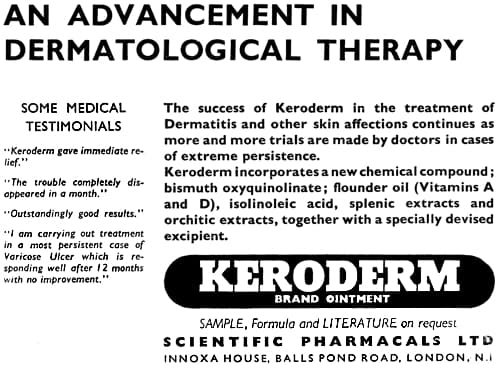
Above: 1947 Industry advertisement for Keroderm.
Keroderm was not strictly a cosmetic and Innoxa (England) placed the product into Scientific Pharmacals Ltd., a subsidiary company it had created in 1939. However manufacturing Kerodex still took place in the Innoxa factory at 233 Balls Pond Road, London.
In 1947, Innoxa (France) introduced Gant Cème Innoxa in two forms: No. 7 for work in water and No. 10 for dry. In 1950, Innoxa (England) followed with two Barrier Creams, No. 71 for wet work and No. 51 for dry. The British creams may have been replicants of the French creams but it is also possible that they were new or modified formulations.

Above: 1953 Industry advertisement for Innoxa Barrier Creams.
Barrier Cream No. 71: “Completely harmless, it will wear off, but not wash off, and will withstand the hardest water and any kind of soap.”
Barrier Cream No. 51: “[M]akes an invisible guard over the skin (and it really is invisible). Having smoothed this on, you can do any kind of household chore.”
See also: Barrier Creams & Lotions
Overseas, Innoxa (England) marketed both barrier creams as Kerodex and this later became the case in the United Kingdom as well.
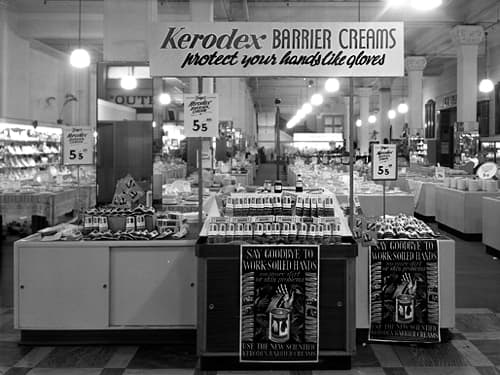
Above: 1952 Kerodex Barrier Cream in the Foy & Gibson’s department store in Perth, Western Australia.
Each barrier cream could be employed separately but Innoxa (England) also suggested they could also be used together. In this situation, No. 71 was applied first, after which the hands were placed under cold water to fix it. Then No. 51 was put on top and could be washed off when the dirty jobs were done.
In 1954, when Innoxa (England) changed the name of its barrier creams in Britain to Kerodex, it transferred them to its Scientific Pharmacals subsidiary, later replaced by a new company, Kerodex Ltd. founded in 1961.
Skin-care
There were few developments in the British Innoxa skin-care range through to 1960 and the skin-care regimes in the late 1940s remained much as they were before the war.

Above: 1948 Innoxa Solution 41, Open Pore Lotion, Complexion Milk, Hand Lotion, Face Powder, Skin Balm, and Mousse (UK).
Women were divided into three age groups – sixteen to twenty-five, twenty-five to forty, over forty – then further divided in three skin types – Dry, Normal and Greasy. Innoxa skin-care treatments for Normal skin types is given below as an example:
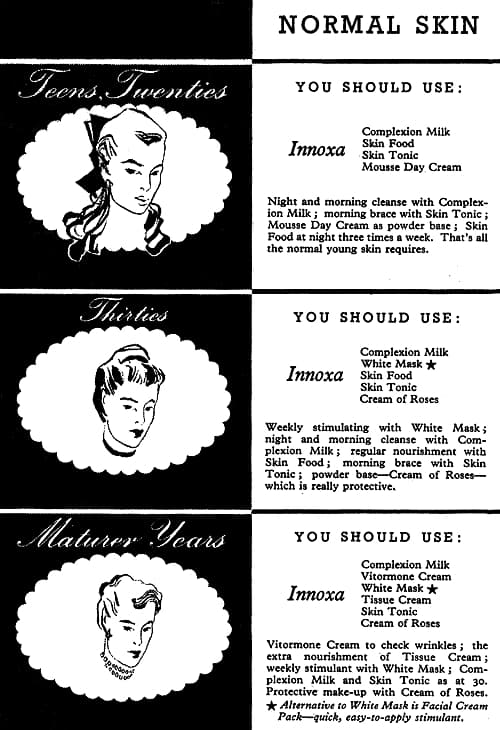
Above: 1948 Innoxa skin-care treatments for normal skin types.
See also: Innoxa Personal Beauty Plan and Make-up Chart (c.1948)
Most of the skin-care cosmetics used in the 1940s were still in production when the British line was repackaged in 1957.

Above: 1957 Innoxa cosmetics in new packaging.
The only major general skin-care cosmetic added by Innoxa (England) through to 1960, that I know of, was Late Night Final, a liquid cleanser. In addition to being a cleanser, it was also suggested for use as night cream where it would eliminate the need to wear ‘grease’ on the face overnight.
Late Night Final: “The first application, smoothed over the face and wiped off with cotton-wool, removes make-up, dust and impurities. The second—just a very little—sinks right in, leaving no surplus grease, and feeds the skin during the night.”
Sun-care
In 1951, Innoxa (England) released a reformulated Innoxa Tan with reduced greasiness, improved water repellence, and higher sun protection. Then, in 1956, it added two new sun-care products: Tan spray, a lightly perfumed oil with an insect repellent in a spray canister; and Tan Oil, a lightly coloured oil to be rubbed into the skin.
Bath products
in 1954, Innoxa (England) introduced a trio of ‘bathtime luxuries’ scented with a new perfume – Paris Mist – package in misty blue cartons embellished with silver stars.
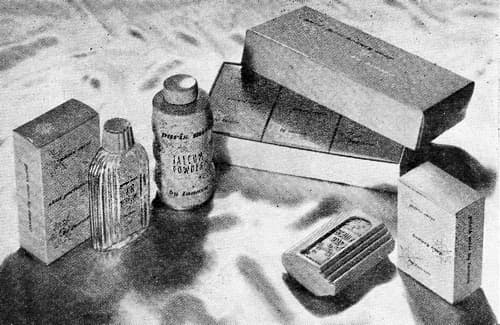
Above: 1954 Innoxa Paris Mist Skin Perfume, Soap and Talcum Powder.
Make-up
During the 1950s and 1960s, Innoxa (England), reformulated many of its existing make-up lines, introduced a new forms of make-up, and widened the shade ranges of many products, especially lipsticks. Make-up would become the primary focus of its advertising campaigns where it was promoted as beneficial for the skin while enhancing beauty.

Above: 1965 Innoxa salon at 170 New Bond Street. The photograph was taken during the filming of ‘Help’. The salon was shut down in December, 1975.
Foundation and Powder
In 1945, Innoxa (England) had four main foundations in its inventory – Foundation Lotion, Cream of Roses, Matine Cream, and Innoxa Mousse. Innoxa Mouse and Matine Cream were colourless while Foundation Lotion and Cream of Roses were tinted. Older women could also use Vitormone Cream, and Innoxa Tan could serve as a foundation in situations where sunburn was likely as, for example, on the beach.
In 1948, Innoxa (England) introduced Fashion Cream in three shades, its first new make-up line after Second World War.

Above: 1954 Innoxa Fashion Cream (UK).
Fashion Cream: “It is far more than ordinary cake make-up and is ideal for all types of skin. Needs no water and keeps the skin soft and radiant.” Shades: Honey Blonde, Sun Glow, and Golden Sand.
The arrival of Fashion Cream may have been the reason why Innoxa (England) reduced the shade ranges of its tinted foundations. Foundation Lotion was now only available in Light, Medium, and Dark, and Cream of Roses was reduced to Olivette, Peach Bloom, and Blonde Tan shades.
In 1956, Innoxa (England) added two new tinted foundations – Compliment for Normal and Dry skin types, and Skin Bloom, a lighter foundation for Oily skin types and younger clients. When released in Britain, both foundations came in the same three shades – Honey Gold, Pink Cloud, and Rose Tan, followed soon after by Amber Rose.

Above: 1956 Innoxa Complement foundation.
Compliment: “Not only does it hold the powder and keep make-up matt for hours, but it keeps the skin supplied with the necessary moisture.”
Skin Bloom: “[A] velvet texture make-up base.”
Skin Bloom was available in Australia in 1954 in Golden Rose, Rose Petal, and Summer Glow shades which is earlier than the British release date. This may reflect the growing independence of the Australian arm of Innoxa once manufacturing began in Sydney and/or the better economic situation in Australia.
In 1958, Innoxa (England) then added Cream Powder in six shades packaged in a crested, lilac plastic case or a more expensive gilt compact.

Above: 1958 Innoxa Cream Powder.
Cream Powder: “[D]eliciously creamy, light and fine, fragrant and daylong-lasting.” Shades: Orient Pearl, Mother of Pearl, Golden Rose, Spanish Rose, Sweetly Pink, and Hawaii, with Honey Beige, and Softly Pink added by 1960.
Initially, Innoxa Face Power remained much as it was in the 1930s. Powder shades available in Britain in 1948 included Naturelle, Peche, Petal, Blush, Champagne, Lotus, Blossom, Pearl, Futura, Aprella, Pereena, Olivette, Blonde Tan, and Beachtan. Later additions included Pink Pearl, and Rose Petal (1953); and Rose (1955). This situation continued until 1956 when Innoxa (England) reformulated it and launched it in a new cypress green and violet powder box in a reduced shade range – Light of Heart, Moondust, Soft Light, Sunkissed, Dawn Sky, Bewitching, Sunrise, and Candlelight.
Lipstick and Rouge
In 1948, Innoxa (England) launched a reformulated lipstick and rouge in matching shades with the lipstick encased in a new blue and gold enamel container. Both cosmetics came in ten new shades, seven of which were suggested as substitutes for older colours: The older Dawn and Mandarin could be replaced with a new Pimpernel; Autumn with Zinnia; Clair and Electric with Geranium; Cardinal and Fonce with Carnation; Mayflower with Rose; and New Petunia with Cyclamen. Only Anemone retained its original name and, like Carnation (Cardinal), did not change its colour.
Almost a decade later, in 1957, Innoxa (England) reformulated and repackaged its lipsticks again creating a ‘complete lipstick wardrobe’ of eight shades in a Grecian case.

Above: 1957 Innoxa Grecian Lipstick n a new silver-plated case.
Grecian Lipstick: “This lipstick has everything! Exciting new colours—a superb texture that’s smooth as satin, stays on all day—and an elegant new case that’s fluted like a Grecian column and plated with real silver.” Shades: Plum Crazy, Fire Dance, Roundabout, Excitement, Postman’s Knock, Palest Pink, Carnival, and Highlight.
Like other lipsticks in the 1950s, Innoxa Grecian Lipsticks were refillable.

Above: 1957 Innoxa Slick-Change Refill.
In Australia, the lipsticks were packaged in a Moss ’n Mauve case. The shade range also differed – Talk-About Pink, Roundabout, Fire Dance, Summer Lightning, Red Pippin, Palest Pink, Strange Lady, and Postman’s Knock – although this may have been in name only.
In 1959, Innoxa (England) introduced its colour-true Jewelfast Lipsticks, also refillable, also in eight shades including Postman’s Knock, Applejack, Pink Gingham, Palest Pink, and Excitement. In 1961, these were matched with new one-coat nail enamels, later rebadged as Jewelfast Nail Enamels.
Jewelfast Lipstick: “[K]eeps its jewelbright glow, its tempting lustre, its moist, satiny look—indelibly.”
1960s
In 1961 Innoxa (England) hosted an International Conference attended by Innoxa delegates from around the world. By then, Innoxa (England) had moved into its new headquarters at Innoxa House, 436 Essex Road, London, situated on the corner of Essex Road and Balls Park Road, Islington, the official opening taking place in 1962. Starting in 1960, the building had undergone an extensive building program to expand and update its facilities. It still stands today but is now known as Leroy House.
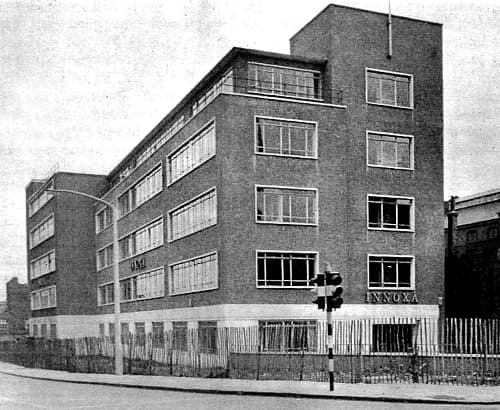
Above: 1962 Innoxa House with offices on Essex Street and factory on Balls Park Road. The building was laid out as follows:
Ground Floor: General storage, and Printing Department.
First Floor: Filling and Finishing Department, Lipstick Department, cream manufacturing facilities, and face powder storage.
Second floor: Research laboratories and the face powder plant.
Third Floor: Despatch Department.
Fourth floor: Management, sales, and export offices, and canteen.
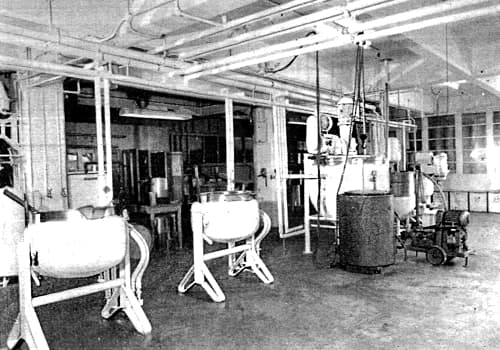
Above: 1962 Cream making plant on the first floor of the Innoxa Factory, England.
Skin-care
In 1961, Innoxa (England) launch a new Cleansing Cream along with Tender Touch. Tender touch was originally developed as a night cream but became the first skin cream Innoxa (England) specifically described as a moisturiser.
Innoxa Cleansing Cream: “This luxuriant light cream smoothes on easily, it cleans deeply and leaves the skin with a velvety finish.
Tender Touch: “[A] revolutionary new moisturiser which is perfect for all skins.
In 1963, Innoxa (England) launched Living Peach Skin Tonic in two strengths. Through the 1960s, company then turned Living Peach into an extended skin-care range starting with Living Peach Cleanser, Living Peach Conditioning Cream, and Living Peach Vitamin Beauty Mask in 1966, followed later by Living Peach Moisturising Lotion.
From the heart of the Living Peach – a promise!
Even under your make-up, your skin will be beautiful. …
Scientists discovered active vitamins in the peach . . . substances used by the fruit for its own firm, ripe freshness. Innoxa chemists found a way to keep these vitamins active, away from the parent fruit . . . they called it accurately “Living Peach”.(Innoxa advertisement, 1976)
In 1968, Innoxa (England) added Innoxa Moisture Oil. It contained amalene, a camomile derivative that the company claimed acted as a moisturiser. Innoxa (France) had used camomile before in Gouttes Bleues. Introduced in France in 1950, it was said to relieve eye strain.

Above: 1953 French pharmacy window display for Gouttes Bleues.
Innoxa (England) went on to add amalene into a wide range of cosmetics in the 1970s starting with Innoxa Clean Face in 1970, followed by Innoxa Super Vitaliser, Innoxa Throat Cream, and Innoxa Eye Cream.
Amalene, the precious extract from camomile, is the special ingredient in all of them.
It replenishes moisture. Plumps out skin tissue.(Innoxa advertisement, 1972 )
Living Peach and Moisture Oil mark the start by Innoxa (England) of a shift to plant-based products and a renewed emphasis on skin-care. Some Innoxa cosmetics still contained ingredients like Turtle Oil and Mink Oil in the 1980s but the company would eventually refrain from using animal ingredients and embrace products that were no longer tested on animals.
Other cosmetics added by Innoxa (England) in the 1960s included On & Off (1966) a depilatory; Sunplay (1966) a series of suntan products available as an oil, cream or lotion; All in One (1968), a hand cream said to be nourishing for the hands and conditioning for the nails; and Cool Hands (1969), a hand cream with a built in antiperspirant.
Youth Market
Until the 1960s, Innoxa (England) had a limited range of products that helped remediate problems in younger skins, primarily Lotion 41, a treatment for pimples, blackheads and acne, first introduced during the Second World War. In 1964, Innoxa (England) added Medicated Soap 41 to help clear the skin, and Innoxa Tinted Foundation 41 to cover skin blemishes. Then, in 1968, it added six more 41 products – Innoxa Moisturising Milk 41, Complexion Milk 41, Hair Shampoo 41, Spray Deodorant 41, and Skin Shampoo 41, collectively advertised as ‘The Big Clean-up’. Cover Stick 41 (Light and Dark shades) and Cream Powder 41 (Golden Sable, Lovelight, Rose Sable, Sable Peach, and Sun Sable shades) were added later in the year. The active ingredient in many of these products was the antimicrobial agent Irgasan, another name for Triclosan. This was not the antimicrobial used in the original Solution 39 or Solution 41, so these products from the 1960s were Solution 41 in name only.
Make-up
Although the 41 range included make-up, much of the general make-up introduced by Innoxa (England) during the 1960s also had younger women in mind.

Above: 1962 Innoxa Cream Powder, Jewelfast Lipstick, Shadow Soft Eye Shadow, as well as Satin Bloom, and Cream Satin Foundations.
Foundation and Powder
In 1961, Innoxa (England) introduced three new foundations, Cream Satin, Satin Bloom and Liquid Satin all in the same six shades – Copper Satin, Satin Blush, Moonlit Satin, Satin Suntan, Pearl Satin, and Golden Satin, with Satin Marshmallow added by 1964. These were used in conjunction with Spunsatin Face Powder which came in ten shades.
Cream Satin: “[A] perfect tinted foundation for dry skins in a none crush tube … which combines moisturising with perfect colour coverage.”
Satin Bloom: “Formulated specially for greasy skins, is economical to use and contains a new typeof lubricant which is neither an oil nor a fat; it affords perfect covering for the skin and is easy to spread. Can be used with or without powder.”
Spunsatin Face Powder: “[S]preads on evenly giving a matt finish.” Shades: Cream Magnolia, Flattery, Lovelight, Say Honey, Soft Twilight, Sweeter than Springtime, Peach Eclair, Moonstone, After Six, and Pacific Tan.
By 1967, Innoxa had introduced Spunsatin Cream Powder to be used as a touch up powder or for all-in-one coverage. It appears to have come in the same shade range as Spunsatin Face Powder but Innoxa (England) also added four new shades to both cosmetics – Sable Beige, Golden Sable, Rose Sable, and Sable Peach.
Lipsticks and Rouge
Jewelfast lipsticks remained the primary lipsticks sold by Innoxa (England) through to the introduction of Super Jewelfast Lipsticks in 1967. New shades included: Red Chiffon, Mermaid Pink, Fire Coral, and Wild Poppy (1960); Plum Crazy, Fresh Tangerine, and Alexandra Rose (1961); Mango Spice, Strawberry Crush, In The Pink, High Society, Madrid, Sugar Bush, Honey Bun, Just Peachy, Peppermint Pink, Cool Coral, Fandango, and Café Olé (1963); Oranges and Lemons, Bow Bell Pink, Flip-Over Honey, Lollypops and Roses, Fashion Talk, and Wild Chinchilla (1964); Sittin’ Pretty, Moods are Pink, and Love and Kisses (1965); Purr-Purr, Red Sapphire, and Knock Out (1966); and Cola-Cola, Fancy That, and For Keeps (1967). Three these, – Sittin’ Pretty, Moods are Pink, and Love and Kisses – were described as ‘see-thru’, meaning that they could be worn alone or applied over other Innoxa shades.
Innoxa had been concerned with lipstick reactions since 1955 at least when Innoxa (England) introduced Lip Barrier Cream This was applied under lipsticks to protect the lips from allergic or irritant reactions.
Lip Barrier Cream: “[A]pplied on and around the lips, left for a minute to dry, and then reapplied. When dry, lipstick may be applied using, as an extra precaution, an eosin-free lipstick.”
Innoxa had sold eosin-free lipsticks before Innoxa (England) launched Innoxa No. 22 Lipsticks for sensitive skin in 1960. I assume the No. 22 was a reference to Innoxa’s Parisian address. The lipsticks were formulated without eosin and also used ‘carefully selected perfumes’ – both features designed help to avoid skin reactions – along with a sun deflectant. It came in Palest Pink, Excitement, Pink Gingham, Applejack, Postman’s Knock, Wild Poppy, Fire Coral, Mermaid Pink, and Red Chiffon shades.
Innoxa (England) also updated their rouges in the 1960s starting with Cheek Glo Cream Rouge in 1962. It came in a lilac-hinged container in Cream Rose, Cream Pink, Cream Honey, and Cream Amber shades. In 1963, this was followed by Soft Echo Power Rouge in Fancy Rose, Fancy Pink, and Fancy Apricot shades, with Tawny-Tawny added in 1968.
Eye make-up
Innoxa (England) began updating and expanding its range of eye make-up in 1961. Starting with Dramatic Mascara, an automatic waterproof mascara in Black Silk, Blue Flattery, Brown Whisper, Royal Purple, and Green Mist shades, this was quickly followed with Dramatic Cream Mascara and Dramatic Eye Liner.
Also see: Automatic Mascara
In 1962, Innoxa (England) then introduced new cream and powder eyeshadows. Shadow Soft Eye Shadow came in Blue, Jade, Smoke, Turquoise, Azure, Lilac, Fawn, Gold, and Silver shades; Satin Cream Eye Shadow in Blue, Turquoise, Grey, Silver, Shadow Green, Shadow Blue, Lilac Satin, Green Silk, and Blue Silk shades.
In 1969, Innoxa (England) then released Masterstroke a super, brush-on automatic mascara with built-in conditioner and protein supplement said to make the lashes grow healthy and lush. Packaged in a white-and-gold case it came in four shades – Black, Dark Brown, Dark Grey, and Dark Blue.
Keromask
Mention should also be made of Keromask. Like Covermark, it was a camouflage make-up used to hide prominent birthmarks, rosacea, varicose veins and large scars. I do not know exactly when it was developed but it seems likely that this took place in the late 1950s. The brand was trademarked by Scientific Pharmacals in 1961 but was later separated out as a separate company. It is still on the market today in Britain and elsewhere.
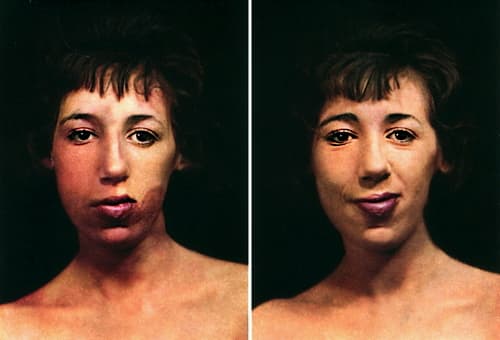
Above: 1963 Before (left) and after (right) application of Keromask.
Also see: Covermark
Later developments
After Dr. François Debat died in 1956 his affairs were taken over by his son Jacques Debat [1914-1997]. The pharmaceutical operations were in decline and, after experiencing financial difficulties in the 1980s, they placed on the market. This situation continued for over a decade before Jacques Debat sold out to Laboratoires Fournier in 1993.
The Debat factory at Garches was shut down after the sale to Fournier but the building and its surrounds are still standing. Most of the gardens are still there and the factory building has been repurposed as a clinic. Fittingly, the street at the back of the complex is now named Rue du Docteur Debat.
The sale to Fournier appears to have included Innoxa but this was sold off and, directly or indirectly, ended up in the hands of Laboratoire Pharmygiène. In 2000, Laboratoires Omega Pharma bought Laboratoire Pharmygiène but, after operating Innoxa (France) for nearly two decades, sold it to Laboratoires Visiomed in 2018. Two years later, Visomed sold Innoxa (France) to LJV Capital, the current owner.
In the United Kingdom, Innoxa (England) bought up a few ailing firms including L. Leichner (London) Ltd. (1966), the British arm of Dorothy Gray (1974), and the British branch of Rose Laird (1981). Following the purchase of Dorothy Gray, Innoxa (England) closed their factory and headquarters in Islington and moved everything to the Dorothy Gray factory in Hawthorn Road, Eastbourne in 1976 and shut down the Innoxa and Dorothy Gray salons. Subsequently, it opened a new London headquarters for Innoxa, Kerodex, Leichner, and Dorothy Gray in Knightsbridge in 1978.
Rose Laird was sold to Silhouette in 1986 but Innoxa (England) still owned L. Leichner and Dorothy Gray when Glopec UK Ltd. bought into the group for £4 million in 1989. Unfortunately, none of the firms in the Innoxa group appears to have survived the 1990s. Innoxa is still available in the UK but is sourced directly from France.
See also: Leichner (post 1945) and Rose Laird
Globec also acquired Innoxa International but sold off the South African and Australian parts to Heritage Brands in 2003. Australia has long been a market for Innoxa and the brand still survives there today.
Timeline
| 1945 | New Products: Keroderm Ointment (UK). |
| 1947 | New Products: Gant Crème (France). |
| 1948 | London salon officially opened at 170 New Bond Street. |
| 1949 | Training School for Beauticians opened in London. |
| 1950 | New Products: Gouttes Bleues (France). |
| 1951 | New Products: Hand Lotion (UK). |
| 1952 | Innoxa (England) opens a factory in South Africa. |
| 1954 | Innoxa (England) opens a factory in Australia. New Products: Paris Mist Skin Perfume, Soap and Talcum Powder (UK). |
| 1955 | New Products: Lip Barrier Cream (UK). |
| 1956 | New Products: Compliment; and Skin Bloom (UK). |
| 1957 | Products repackaged (UK) New Products: Grecian Lipsticks (UK). |
| 1958 | New Products: Cream Powder (UK). |
| 1959 | New Products: Jewelfast Lipsticks (UK). |
| 1960 | New Products: Innoxa No. 22 Lipsticks (UK). |
| 1961 | Kerodex Ltd. founded. Innoxa (England) headquarters moved to Essex Road. New Products: Cleansing Cream; Tender Touch; Cheek Glow Cream Rouge; Cream Satin; Satin Bloom; and Liquid Satin (UK). |
| 1962 | Kerodex Ltd. founded in Britain. New Products: Shadow Soft Eye Shadow; and Satin Cream Eye Shadow (UK). |
| 1963 | New Products: Soft Echo Power Rouge; and Living Peach Skin Tonic (UK). |
| 1964 | New Products: Tinted Foundation 41; and Innoxa Medicated Soap (UK). |
| 1966 | Innoxa (England) Ltd. acquires L. Leichner (London) Ltd. Keromask Clinic moves to 44a Cranbourn Street, London. New Products: Living Peach Cleanser; Living Peach Conditioning Cream; and Living Peach Vitamin Beauty Mask (UK). |
| 1967 | New Products: Super Jewelfast Lipsticks (UK). |
| 1968 | New Products: Moisturising Milk 41; Complexion Milk 41; Hair Shampoo 41; Spray Deodorant 41; Skin Shampoo 41; Cover Stick 41; Cream Powder 41 (UK). |
| 1969 | New Products: Masterstroke mascara (UK). |
| 1974 | Dorothy Gray Ltd (Britain) acquired by Innoxa (England) Ltd. |
| 1975 | London salon closed. |
| 1976 | Innoxa (England) factory and headquarters moves to Hawthorn Road, Eastbourne. |
| 1978 | Innoxa (England) group of companies moves to 62 Brompton Road, Knightsbridge. |
| 1981 | Innoxa (England) acquires Rose Laird Ltd. (UK) from Cuticura Laboratories. |
| 1986 | Rose Laird Ltd. (UK) sold to Silhouette International Ltd. |
| 1989 | Glopec UK Ltd. invests in Innoxa (England) Ltd. |
| 1990 | Innoxa International Ltd. acquired by Glopec Holdings Ltd. |
| 1993 | Laboratoires Fournier acquires Laboratoires Debat. |
| 2000 | Laboratoires Omega Pharma buys Laboratoire Pharmygiène. |
| 2003 | Innoxa (Australia and South Africa) bought by Heritage Brands from Glopec Holdings. |
| 2018 | Laboratoires Visiomed buys Innoxa from Laboratoires Omega Pharma. |
| 2020 | Innoxa acquired by LJV Capital from Laboratoires Visiomed. |
First Posted: 30th May 2021
Last Update: 15th April 2024
Sources
The American Perfumer & Essential Oil Review. (1906-1955). New York: Robbins Perfumer Co. [etc.].
Around the beauty parlours No 3. Innoxa. (1948). Beauty Aids: A quarterly review of the British perfumery, cosmetic, hairdressing and allied trades., pp. 34-37.
The chemist and druggist. (1859-) London: Morgan Brothers.
The house of Innoxa: Past, present and prospects for the future. (1962). Soaps, perfumery & cosmetics. August, 716-720.

1953 Dr. François Debat [1882-1956] in Academy uniform. He was made a member of the Académie des Beaux-Arts in 1947. He is also wearing a Legion of Honour (Chevalier) medal he received in 1938.

1948 Lait Innoxa and Le Gant Crème Innoxa.

1948 Innoxa Dry Skin treatment (UK).
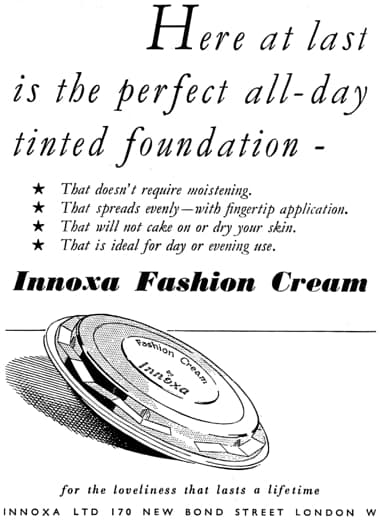
1948 Innoxa Fashion Cream (UK).
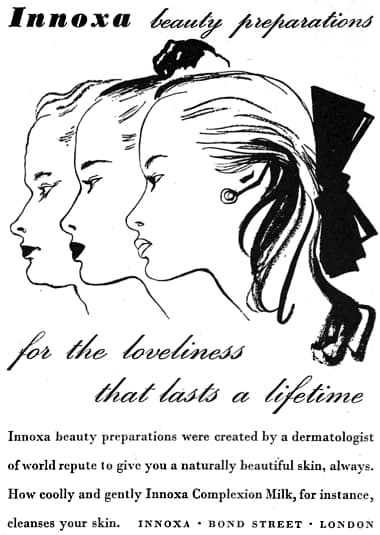
1948 Innoxa Complexion Milk (UK).
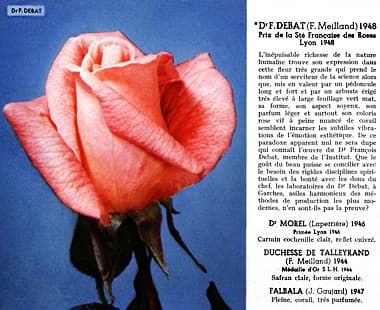
1948 Dr. F. Debat Rose, reflecting Debat’s interest in the therapeutic effect of gardens.

1949 Innoxa Lipstick.

1949 Innoxa Fashion Cream (Australia).
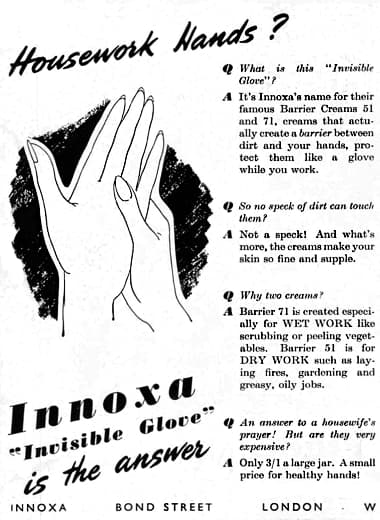
1950 Innoxa Invisible Gloves (UK).
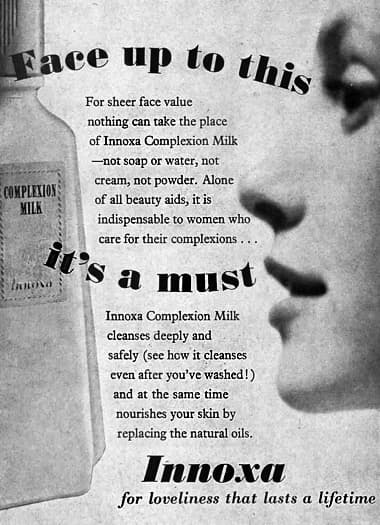
1950 Innoxa Complexion Milk (UK).
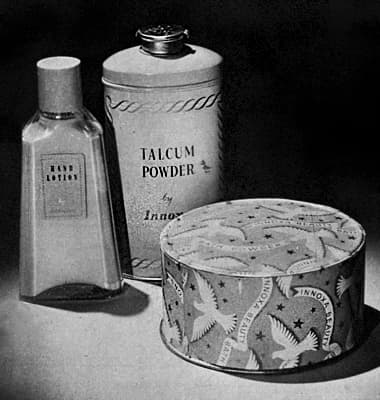
1950 Innoxa Hand Lotion, Talcum Powder and Bath Powder (UK).
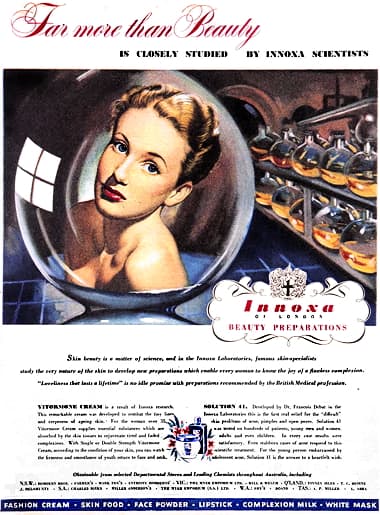
1950 Innoxa Vitormone and Solution 41 (Australia).
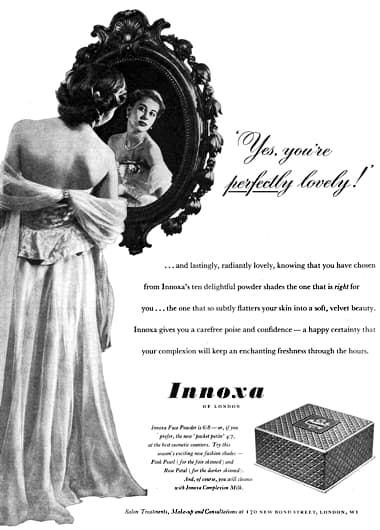
1953 Innoxa Face Powder (UK).
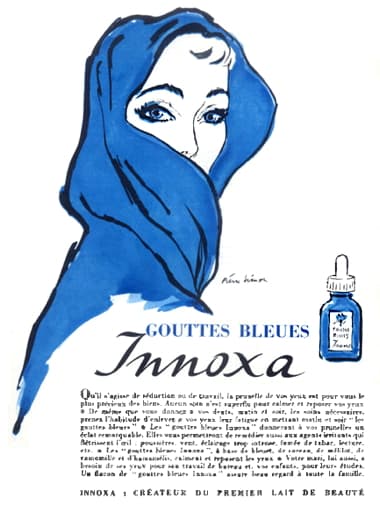
1953 Innoxa Gouttes Bleues.

1955 Innoxa Late Night Final (UK).

1955 Innoxa Lipstick (UK).

1957 Innoxa Grecian Lipstick (UK).

1957 Innoxa Compliment (UK).
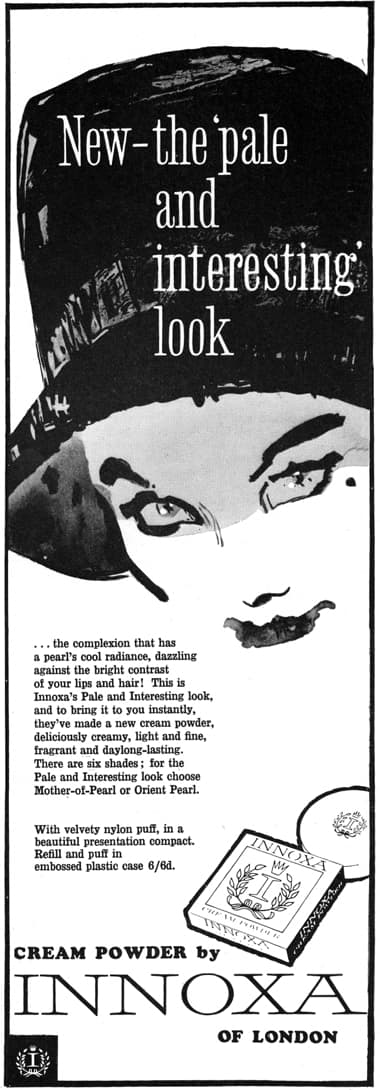
1958 Innoxa Cream Powder (UK).

1960 Innoxa (UK).

1961 Innoxa Jewelfast Lipsticks (UK).

Above: 1962 Delegates at the International Conference. The three men in the front are (from left to right) Mr. Michael Alberman, Mr. Albert Alberman and Dr. Kenneth Alberman.
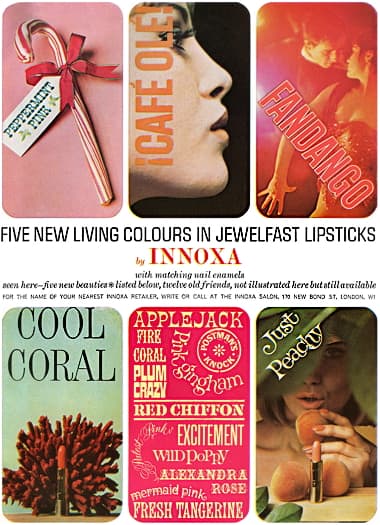
1963 Innoxa Jewelfast Lipsticks (UK).

1967 Innoxa (France).
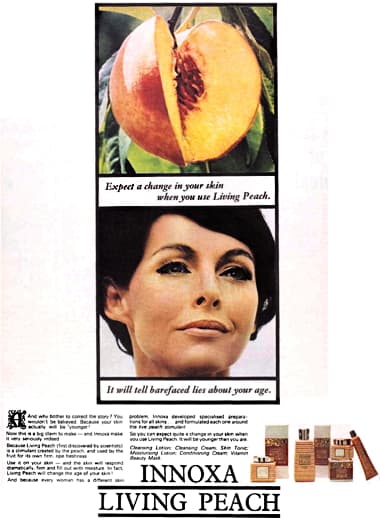
1967 Innoxa Living Peach (Australia).

1968 Innoxa Super Jewelfast Lipsticks (Australia).
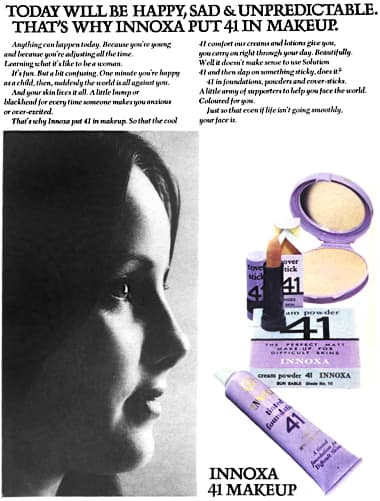
1969 Innoxa Cover Stick 41, Cream Powder 41, and Tinted Foundation 41 (Australia).
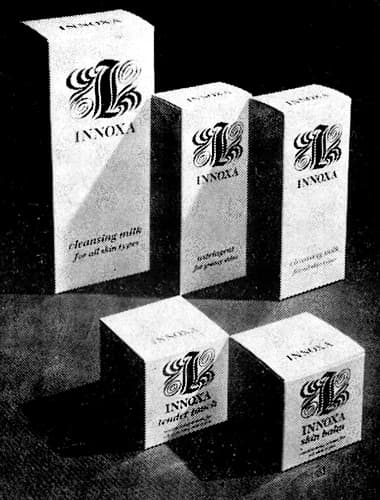
1969 Innoxa packaging.

1970 Innoxa Clean Face (UK).
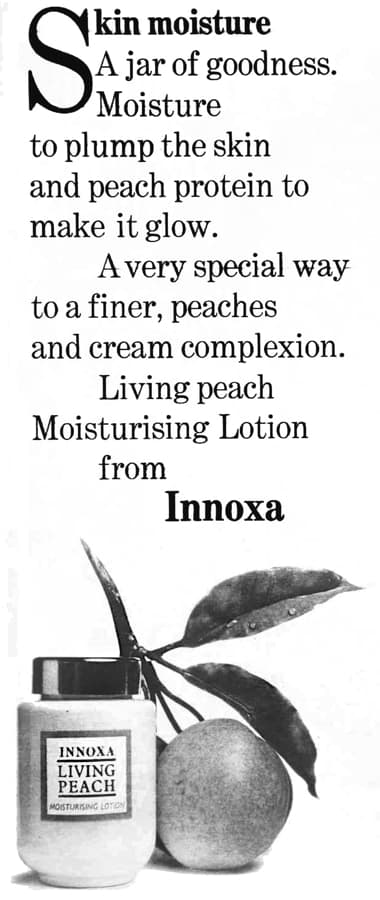
1970 Innoxa Living Peach (Australia).
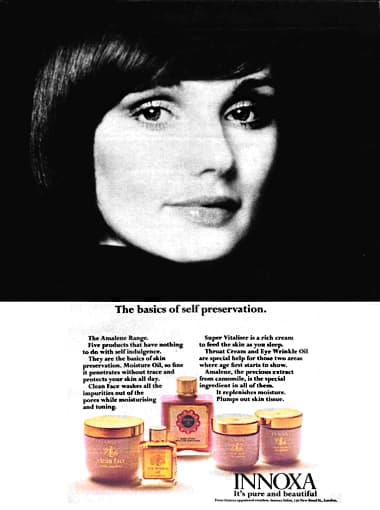
1972 Innoxa cosmetics with amalene (Australia).
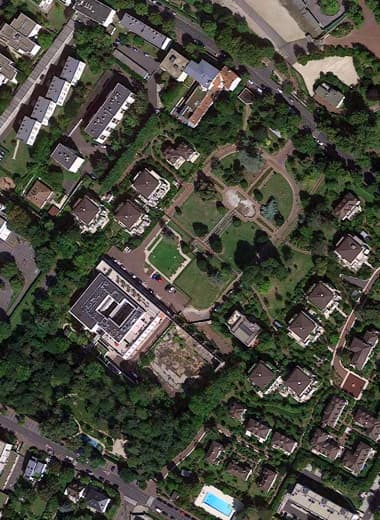
Google maps view of the Dr. Debat factory site at Garches. Part of the factory has been demolished but much of the building still stands. The residential buildings including the meeting hall with its circular tower are also still there as are most of the gardens.
